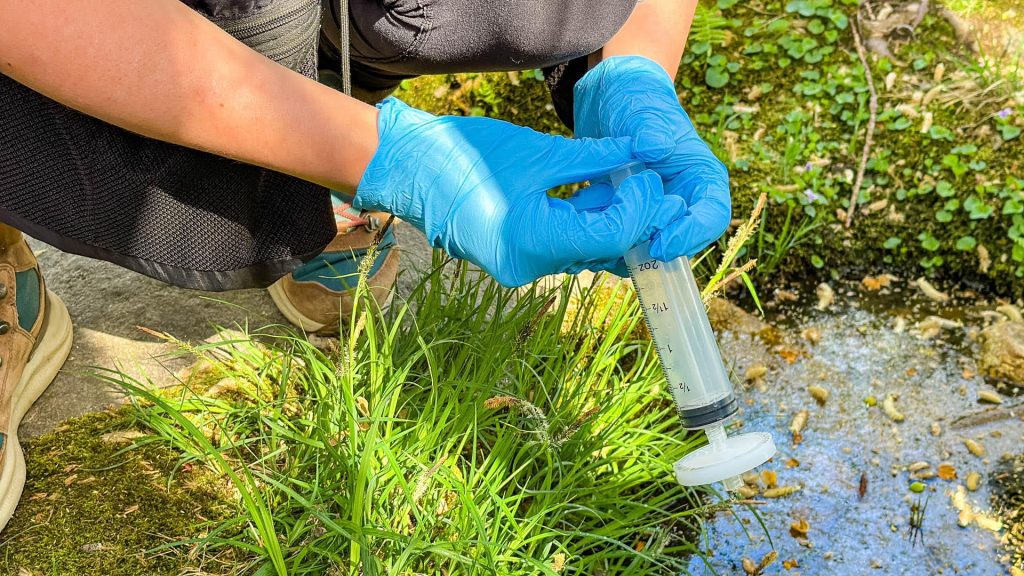In Mondim de Basto, Portugal, tourists on a small group tour with Exodus Adventure Travels lean over a clear river from a grassy bank, collect water, and push it through a filter. Once finished, the filter will be sent to a lab for analysis. The lab will document the DNA collected to show which species are present in local waterways, all to fill gaps in global biodiversity data.
On an expedition off the coast of Greenland, passengers on the small HX (formerly Hurtigruten Expeditions) ship look over the edge of a zodiac, watch as a white disk disappears beneath the waves to take a depth measurement, and submit it using an app to scientists who can then study phytoplankton.
[ Related: How to participate in citizen science and when to let professionals handle it ]
None of the people collecting this data are professional scientists; they are just regular travelers with a strong curiosity and a wish to improve the distant places they visit by taking part in citizen science. Data collection isn’t only for researchers–travelers are often very well-suited to help strengthen the lack of documented data across scientific fields worldwide.
While the term citizen science may sound amateur (how much reliable information can individuals without doctorates in chemistry or biology even contribute?), the areas of scientific study that use information gathered by everyday individuals span a wide range, from environmental science to marine biology.
And the data non-scientists can provide is often extremely valuable.
In fact, one study showed that citizen-collected scientific data contributes, or could potentially contribute, to 40 percent of United Nations Sustainable Development goals. It offers grassroots organizations and small operations a way to access centralized knowledge, which is paramount in modern scientific communities and informs peer-reviewed studies and results in meaningful research.
One study from 2021 used citizen-collected data to help with a paper on ocean transparency while another study from 2023 used publicly-collected data to study and report on algae blooms in natural waterways.
How does your summer vacation fit in? Seamlessly.
“We are privileged enough to spend a lot of time in extremely remote areas where conducting scientific research has very high costs and is often prohibitive for some scientists,” explains Marcos Goldin, geologist and citizen science coordinator at sustainably-minded expedition cruise line Aurora Expeditions.
So citizen science provides a way to collect and share data from not just easily-reachable fields of study, but across the globe, including in often underrepresented, neglected or hard-to-reach parts of the world where the greatest data gaps tend to exist. In short, travel, especially the kind that involves going off-the-beaten track, is the perfect excuse to collect and record meaningful data.
Learn while you play
But the value this information brings to the scientific community isn’t all citizen science projects are good for. “These programs also create unique opportunities for education, enhancing travelers’ understanding of the unique regions and ecosystems that we often visit, and their importance to the overall health of our planet,” Goldin says, referring to the positive effects on society and the environment that traveling can bring.
“When you are on vacation and actively understand your role as an individual, you can feel a deeper connection to the community and the places you visit,” says Rochelle Turner, head of sustainability at Exodus Adventure Travels, a tour company that offers several trips with a strong citizen science aspect. One of these involves working with NatureMetrics in partnership with the International Union for Conservation of Nature (IUCN) to gather water samples in various destinations. The results from these samples contribute to the eBioAtlas, a global biodiversity database that maps the distribution of species across the world.
This database is accessible to researchers and conservationists locally and internationally to assist in land and water management, provide a plan for healthy ecosystems, and update the IUCN Red List of Threatened Species, highlight important biodiversity areas, and more.
Similarly, some small expedition cruises like Aurora Expeditions and HX offer science programs on their ships, such as studies on microplastics in the Arctic or identification of whales or birds, many of which add significance to a trip and nurture a closer bond with nature, emphasizing the need to protect it and ultimately transform a destination, according to Turner.
“We are all increasingly aware that travel is about much more than just visiting a new place,” adds Goldin. “We believe responsible travel should not only involve respecting the destination’s environment but should also strive to make positive contributions and leave the place better than we found it.”
Travelers can also witness the results of their efforts, either through the reports Exodus sends to guests after the trip, by observing phytoplankton under a microscope in the lab, or through regular updates when wildlife is spotted elsewhere in the world.
Discover a citizen science experience
Fortunately, more and more travel companies, from Linblad Expedition cruises to Intrepid Travel tours, provide citizen science opportunities in various locations from polar regions to the Amazon. Many environmentally-conscious companies prominently feature citizen science projects in their marketing, making them easy to find.
I can engage in science on my own
However, you don’t need to book a dedicated tour or cruise to take part in citizen science projects when traveling. To contribute to many databases, all you need is your phone: There are several free apps available that guide you through the process of recording information on various subjects, from clouds to birds to whales.
Other projects, like collecting phytoplankton readings using a Secchi Disk, may require a few additional tools.
[ Related: You can help assess the ocean’s well-being with this homemade device ]
If you choose to do it independently, be sure to carefully read and follow the instructions. Most apps will guide you through the process. Then, use them as frequently as you wish while traveling.
“By participating in Citizen Science, we can genuinely make a positive impact on the places we visit and contribute to their future protection,” says Goldin.









